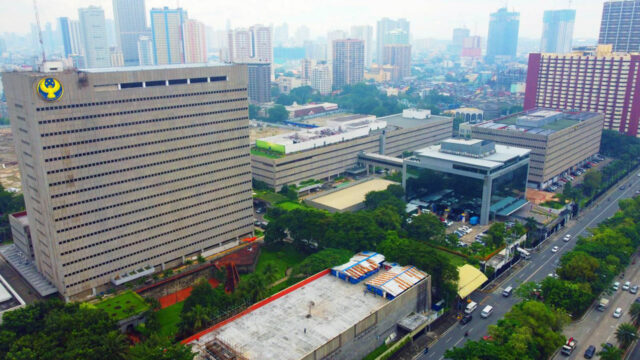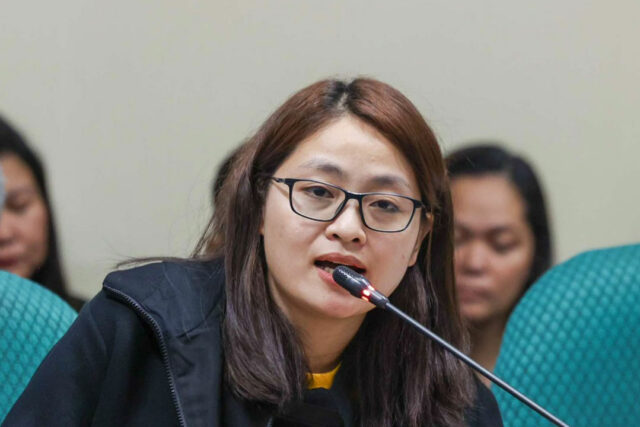The Senate Committees on Women, Children, Family Relations and Gender Equality, and on Public Order and Dangerous Drugs resumed on Sept. 9 their joint inquiry into the illegal Philippine offshore gaming operations (POGO) of dismissed Bamban, Tarlac mayor Alice Guo.
The hearing started with panel chairperson Sen. Risa Hontiveros moving to cite Ms. Guo in contempt for insisting that she and Guo Hua Ping are not the same person. “The National Bureau of Investigation has confirmed that she is Guo Hua Ping, a Chinese national who entered here in 2003. That means she blatantly lied before us in the Senate,” Ms. Hontiveros said.
Ms. Hontiveros said previous hearings have established that Ms. Guo filed a late registration of live birth and was issued a certificate, which she used to obtain a Philippine passport. “The Philippine Statistics Authority has declared the certificate as irregular,” the senator explained. “Guo Hua Ping, do not continue to insult us,” she warned her.
She ended her opening statement by reminding her colleagues that “the primary purpose of the hearings is to craft better laws and policies. We have identified gaps in birth registration, border control, cyber fraud, and others. We should make sure our hearings achieve this purpose.”
Next to deliver an opening statement was Senate President Pro Tempore Jinggoy Estrada, ex-oficio member of all committees. He asked, “Alice Guo, who are you really? We all know that you are not a Filipino, that you did not grow up in a farm, that you are not an ordinary citizen. Twenty-eight billion flowed through your account, in contrast to your story that you were engaged in poultry raising and to your company’s meagre earnings. When you appeared here you were under oath, but you fearlessly fabricated stories and fed Filipinos a pack of lies.”
The senator then castigated Ms. Guo for “mocking government processes, [having] disrespected the electoral system, insulted the Filipino people by believing that by running for mayor she would never be caught.” He should have castigated the government agencies which were remiss. They were represented in the hearings.
He closed by saying: “We wish to know who helped Alice and her companions leave the Philippines without going through the proper processes. Certainly, we also want to know how Chinese nationals pretending to be Filipinos were allowed to open businesses under their names and to use Filipinos as dummies and how they were able to circumvent Constitutional provisions limiting foreign equity to 40%. They violated many laws. It is but proper that they be made to answer. We will not let them get away with it.”
Next to give an opening statement was Sen. Joel Villanueva, who is neither a regular nor ex-officio member of any of the committees. He was, until recently, Majority Floor Leader. Looking at Ms. Guo, he said sternly, “Alice, you disrespected and degraded the Philippine government and the Filipino people. I do not understand why when you were caught you made it appear it was nothing to you. We got offended. I do not know why you seem to consider us your enemies.”
He then delivered a speech on the virtues and integrity of the Senate. He perorated: “The truth is Alice, if you tell the truth, we here in the Senate are your true allies. We will give you a chance again today to reveal the truth. For even if you do not reveal the truth, this is the Senate. This is not a fair. We are sure the truth will come out in the Senate.
“If you are a true Filipino, you should know that the Senate is the pillar of democracy. This is the one that brings out the truth. If you tell the truth, the Senate will surely protect you more than any other agency or institution in this country. This is your opportunity, Alice, if you tell the truth, it is not only you who will benefit but the whole country as well.
“We wish to tell our countrymen the importance of what we are doing, not just in aid of legislation but to ensure we put a period, an end to this horrible and terrible POGO.”
Joel Villanueva exalting the Senate was sheer gall. Eight years ago this month, on Sept. 19, 2016 to be exact, Sen. Leila de Lima was not only removed from the chairmanship of the Senate Committee on Justice, she was ousted from the committee itself for telling the truth. As chairperson of the Committee on Justice at the time, she was extensively and intensely investigating the bloody war on drugs that Davao City Mayor Rodrigo Duterte waged in that city.
Mr. Villanueva was one of the 16 senators who voted for Ms. De Lima’s ouster. The others were Senators Nancy Binay, Alan Peter Cayetano, JV Ejercito, Sherwin Gatchalian, Loren Legarda, Koko Pimentel, Grace Poe, Cynthia Villar, and Migz Zubiri, all re-elected in 2022. In effect, De Lima’s fellow senators, among them Liberal Party-mate Villanueva, gagged her from further telling the truth about extra-judicial killings in Davao City.
Senators Pimentel, Gatchalian, Ejercito were present when Mr. Villanueva said: “The Senate is the one that brings out the truth. If you tell the truth, the Senate will surely protect you.” I wonder what they thought of the pompous speech. Ms. Hontiveros must have twisted and twitched in her seat. She had valiantly opposed Ms. De Lima’s ouster.
Congressional hearings are opportunities for showing profundity, inquisitiveness, and eloquence. But oftentimes they turn into a display of inanity, inquiry into gossip, and babble. That is what the hearings of the Committee on Women, Children and Gender Equality often are.
In spite of avowals of fidelity to the real purpose of congressional hearings — to craft better laws and formulate good policies — some of the questions asked the resource persons in the on-going hearings were:
“Miss Alice, are you Guo Hua Ping?”
“When did you and Mayor Calugay got to know each other?”
“Why are you wearing each other’s campaign shirt?
“Do you and Alice have a romantic relationship?”
“What is the name of your live-in partner?”
“Does your live-in partner know Alice?”
“Why was your godfather with you when you and your boyfriend went on a trip?”
“Did you know what you were doing when you notarized an affidavit (of an affiant who was not present)?”
In the hearing on Sept. 17, Ms. Hontiveros said in her opening statement that they had managed to identify gaps in border control, the system of granting visas, law enforcement, and birth registration. These have led to the crafting of an amendment to the Anti-Financial Account Scamming Act and amendments to the Expanded Anti-Trafficking in Persons Act. They have also gathered information that has resulted in the filing of criminal charges against several individuals.
If so, the committee’s inquiry into Alice Guo’s alleged involvement in the POGO hub in Bamban should have been put to a close. However, in the same Sept. 17 hearing, Sen. Jinggoy Estrada said in his opening statement, “We are far from over. However, even if we get almost nothing from asking you (addressing Alice Guo), and even if you mislead this committee with your answers, we will not stop here in the Senate.”
The “Alice Guo TV dramedy series” starring Jinggoy and Joel must go on. Joel upstaged Jinggoy and Risa in the Sept. 17 episode. He stole the scenes and lines of his co-stars. He just butted in when the situation was nearing a dramatic point — to the visible annoyance of main character Risa. And Joel really stretched his verbose and repetitive lines, prompting Risa to cut him off many times.
It has been said so often that televised congressional investigations are really in aid of re-election instead of in aid of legislation. That may be true of the televised investigations being conducted jointly by the House of Representatives Committees on Dangerous Drugs, Public Order and Safety, Human Rights, and Public Accounts. Most of the members of the committees will be up for re-election in May of next year.
That may not be said of the inquiry being done by the Senate. The terms of senators Hontiveros, Estrada, and Villanueva will expire in 2028. They cannot be thinking of re-election at present. Neither can they be thinking of running for higher office as elections for president and vice-president are not scheduled until 2028.
But then there is the Senate presidency to aspire for. The Senate president is third in the line of succession. In our present volatile political situation, when there are threats of coups and talk of impeachment, the position of Senate president is crucial.
Oscar P. Lagman, Jr. has been a keen observer of Philippine politics since the late 1950s.












